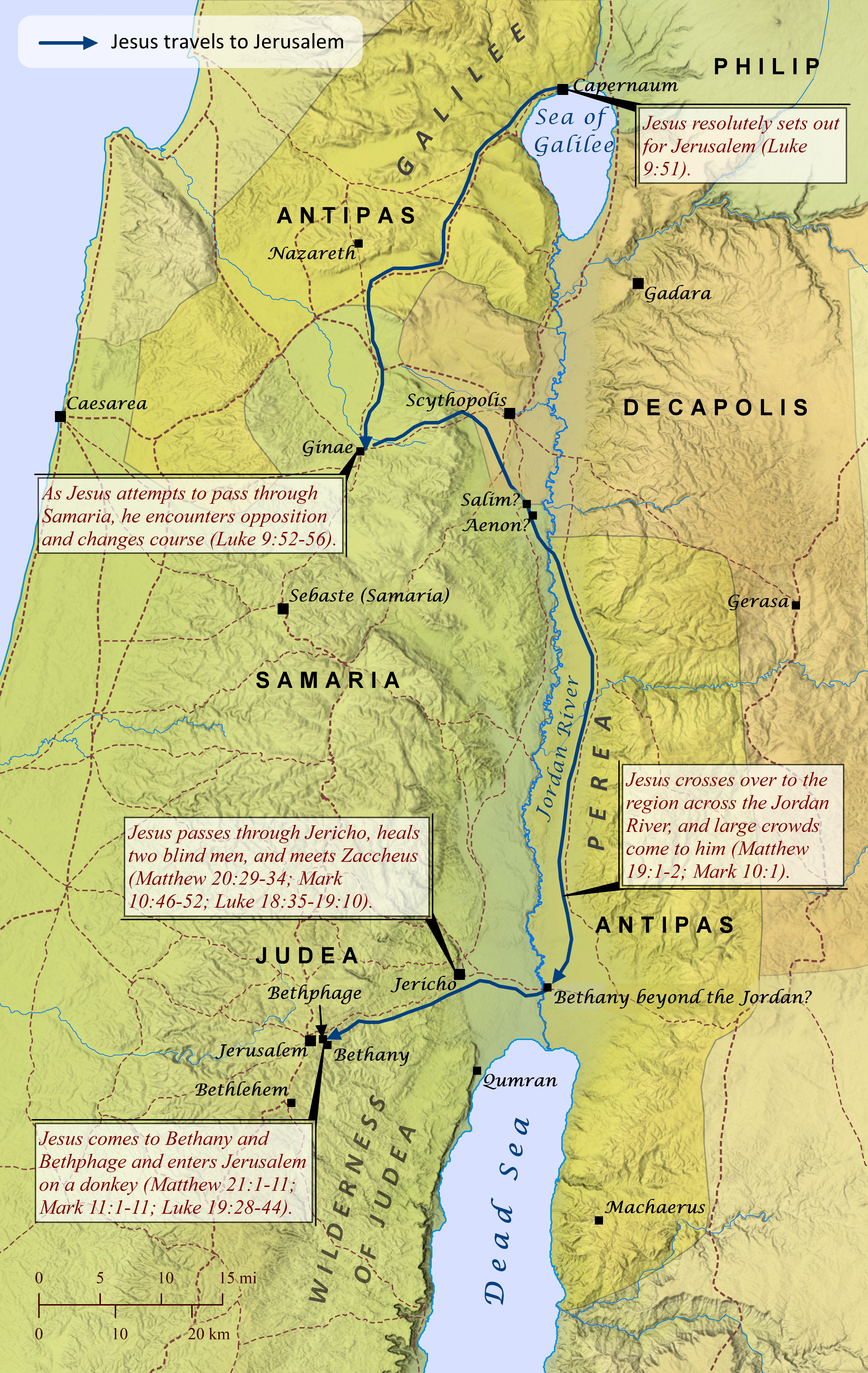Note: This view shows ‘verses’ which are not natural language units and hence sometimes only part of a sentence will be visible—click on any Bible version abbreviation down the left-hand side to see the verse in more of its context. Normally the OET discourages the reading of individual ‘verses’, but this view is only designed as a tool for doing comparisons of different translations—the older translations are further down the page (so you can read up from the bottom to trace the English translation history). The OET segments on this page are still very early looks into the unfinished texts of the Open English Translation of the Bible—please double-check these texts in advance before using in public.
AICNT As he approached Jericho, a blind man was sitting by the road begging.
OEB ¶ As Jesus was getting near Jericho, a blind man was sitting by the roadside, begging.
WEBBE As he came near Jericho, a certain blind man sat by the road, begging.
WMBB (Same as above)
NET As Jesus approached Jericho, a blind man was sitting by the road begging.
LSV And it came to pass, in His coming near to Jericho, a certain blind man was sitting beside the way begging,
FBV As Jesus approached Jericho a blind man was sitting beside the road begging.
TCNT As Jesus drew near to Jericho, a blind man was sitting by the road begging.
T4T As Jesus and his disciples came near to Jericho city, a blind man was sitting beside the road. He was begging for money.
LEB ¶ Now it happened that as he drew near to Jericho, a certain blind man was sitting on the side of the road begging.
BBE And it came about that when he got near Jericho, a certain blind man was seated by the side of the road, making requests for money from those who went by.
Moff As he approached Jericho, it chanced that a blind man was seated beside the road begging.
Wymth As Jesus came near to Jericho, there was a blind man sitting by the way-side begging.
ASV And it came to pass, as he drew nigh unto Jericho, a certain blind man sat by the way side begging:
DRA Now it came to pass, when he drew nigh to Jericho, that a certain blind man sat by the way side, begging.
YLT And it came to pass, in his coming nigh to Jericho, a certain blind man was sitting beside the way begging,
Drby And it came to pass when he came into the neighbourhood of Jericho, a certain blind man sat by the wayside begging.
RV And it came to pass, as he drew nigh unto Jericho, a certain blind man sat by the way side begging:
SLT And it was in his drawing near to Jericho, a certain blind sat by the way, begging:
Wbstr And it came to pass, that as he had come nigh to Jericho, a certain blind man sat by the way side begging;
KJB-1769 ¶ And it came to pass, that as he was come nigh unto Jericho, a certain blind man sat by the way side begging:
KJB-1611 ¶ And it came to passe, that as he was come nigh vnto Iericho, a certaine blinde man sate by the way side, begging,
(Modernised spelling is same as from KJB-1769 above, apart from punctuation)
Bshps And it came to passe, that as he was come nie vnto Hierico, a certayne blynde man sate by the wayes syde, beggyng.
(And it came to pass, that as he was come nie unto Hierico, a certain blind man sat by the ways side, begging.)
Gnva And it came to passe, that as he was come neere vnto Iericho, a certaine blinde man sate by the way side, begging.
(And it came to pass, that as he was come near unto Yericho, a certain blind man sat by the way side, begging. )
Cvdl And it came to passe, whan he came nye vnto Iericho, there sat one blynde by the waye, and begged.
(And it came to pass, when he came nigh/near unto Yericho, there sat one blind by the way, and begged.)
TNT And it came to passe as he was come nye vnto Hierico a certayne blynde man sate by the waye syde begginge.
(And it came to pass as he was come nigh/near unto Hierico a certain blind man sat by the way side begginge. )
Wycl But it was don, whanne Jhesus cam nyy to Jerico, a blynde man sat bisidis the weie, and beggide.
(But it was done, when Yhesus came nigh/near to Yerico, a blind man sat besides the way, and begged.)
Luth Es geschah aber, da er nahe zu Jericho kam, saß ein Blinder am Wege und bettelte.
(It happened but, there he near to/for Yericho came, sat a Blinder in/at/on_the ways and bettelte.)
ClVg Factum est autem, cum appropinquaret Jericho, cæcus quidam sedebat secus viam, mendicans.[fn]
(Done it_is however, when/with appropinquaret Yericho, cæcus some sedebat otherwise/wrongly way/road, mendicans. )
UGNT ἐγένετο δὲ ἐν τῷ ἐγγίζειν αὐτὸν εἰς Ἰερειχὼ, τυφλός τις ἐκάθητο παρὰ τὴν ὁδὸν ἐπαιτῶν.
(egeneto de en tōi engizein auton eis Iereiⱪō, tuflos tis ekathaʸto para taʸn hodon epaitōn.)
SBL-GNT Ἐγένετο δὲ ἐν τῷ ἐγγίζειν αὐτὸν εἰς Ἰεριχὼ τυφλός τις ἐκάθητο παρὰ τὴν ὁδὸν ⸀ἐπαιτῶν.
(Egeneto de en tōi engizein auton eis Ieriⱪō tuflos tis ekathaʸto para taʸn hodon ⸀epaitōn.)
RP-GNT Ἐγένετο δὲ ἐν τῷ ἐγγίζειν αὐτὸν εἰς Ἰεριχώ, τυφλός τις ἐκάθητο παρὰ τὴν ὁδὸν προσαιτῶν·
(Egeneto de en tōi engizein auton eis Ieriⱪō, tuflos tis ekathaʸto para taʸn hodon prosaitōn;)
TC-GNT Ἐγένετο δὲ ἐν τῷ ἐγγίζειν αὐτὸν εἰς [fn]Ἰεριχώ, τυφλός τις ἐκάθητο παρὰ τὴν ὁδὸν [fn]προσαιτῶν·
(Egeneto de en tōi engizein auton eis Ieriⱪō, tuflos tis ekathaʸto para taʸn hodon prosaitōn; )
Key for above GNTs: yellow:punctuation differs, red:words differ (from our SR-GNT base).
